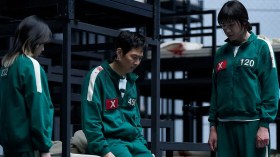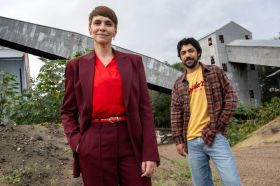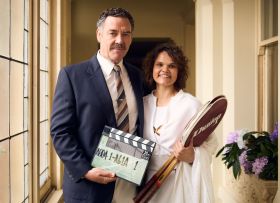No, success for Australian producers is not about a cute dog and a winsome child. Please don’t make a rule about it. Image: Oddball.
Is cinema success a kind of voodoo? William Goldman in his lauded book Adventures in the Screen Trade spoke for generations of busted executives when he said, ‘Nobody knows anything…… Not one person in the entire motion picture field knows for a certainty what’s going to work. Every time out it’s a guess and, if you’re lucky, an educated one.’
Yet we all think we learn from life and our momentary victories add up to something, an angle which maximises the odds of success. Meanwhile, the agencies relentlessly try to reduce risk by asking for gold stars like cast or marketplace attachment or track record or a development shaman who once worked for Roger Corman.
For at least twenty years, the Australian Film Commission and Screen Australia has sustained a rigorous research department determined to stay above prevailing theory and create an institutional memory which transcends the flow of people and contracts. The enemy is secrecy at every stage from deals to personal regrets. The dark forces are confidentiality clauses and the Tax Act. The heroes are those few producers prepared to reveal their finance plans and returns.
I, for instance, regularly ask the question I know our readers want to know: what is your budget? I virtually never get an answer, and never for print. Our readers get hints and cloudy euphemisms. The truth is that budgets change, the numbers affect the deals with agents, and nobody wants to release a film scarred with the low budget label.
Screen Australia employs veteran industry journalist Sandy George to work with the research group to produce Screen Intel, which is by a long shot the best and most authoritative source of analysis in the sector.
George and Screen Australia recoupment manager Bernadette Rheinberger have now published a commercial analysis of 94 films with the agency’s investment. They claim, ‘It identifies those that have excelled according to various indicators and will ultimately reveal which of the films are most successful to date – and why.’
These indicators are not formulae for success, but simply positive elements, of course. The introduction points to six factors in most of the ten biggest hits in the Australian market.
The average budget of the top 10 films was $12.89 million, nearly twice that of all 94 films in the sample. Eight films already existed in another form, that is, they were adaptations or sequels. There was a preponderance of drama and all the films were classified G (general), PG (parental guidance) or M (mature). The level of experience within the director/writer/producer team was significant. The majority of the films had cast beloved by Australians. All but one of the films was released on more than 220 screens.
On a personal note, Sandy George and Bernadette Rheinberger add this:
The writers of this analysis think it has to pull a little at the heart strings and be a bit daggy (SG) and to appeal across age and gender and suit the shared experienced that is cinema (BR). Screen Australia’s distribution manager Anthony Grundy says there’s no secret formula: to cut through the clutter and become the audience’s first choice, a film has to be highly entertaining, authentic and well-made but most of all have a strong emotional hook.
Perhaps the most heartening note in the analysis is about budget. Over half of the 94 films cost less than $5m, including Paper Planes and Last Cab to Darwin which are in the top ten list. Beneath them, in the list of top ten films made for less than $5m we find Wish You Were Here, The Turning, Snowtown, Matching Jack, A Month of Sundays, Goldstone, Charlie’s Country and The Waiting City.
This tells us nothing about the performance of radically low budget films, because the list is restricted to films which have Screen Australia investments.
The research can be found in Commercial analysis and Performance in Australian cinemas, with two more episodes yet to run.
While the sector is desperate for useful strategies to build films, the use of analytical tools brings its own dangers.
Commissioning editors claim to know their audiences, the formulae for their slots and the budgets required to achieve them. That data is a recipe for increasingly miserable repetition, so they are simultaneously looking for fresh new approaches and talent. But tensions are usually resolved in favour of safety.
The consequences of the hunt for successful formulae are so large they are almost invisible. We know that Hollywood is driven by sequels and adaptations, and we sense the cumulative danger of that lumbering line of adolescent fantasies which pour off the LA assembly line. But the problem goes deeper than this.
Popular cinema in the English speaking Western world, hypnotised by the success of the studios, is stuck inside very limited models of agency, of human character, of the mythic journey. Only one man (and now one muscley woman) can save the world, and we invoke tribal storytelling in Europe and Joseph Campbell and The Hero’s Journey to justify it.
The problem is most obvious in animation, which is driven by the same old, same old model of childhood development. You will never be happy until you know who you are, and then you will be the perfect hero. Trust me, I am a development executive and I know the truths of the human heart.
Why does this happen? Two reasons – slavish imitation and gut grinding terror that William Goldman is right. But in fact, the absence of a formula is a recipe for freedom and responsibility. And to look beyond our own culture for the shape of our stories.





